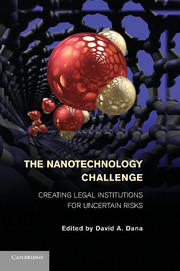Book contents
- Frontmatter
- Contents
- Contributors
- Part I Introduction
- Part II Public Perceptions of Nanotechnology Risks
- Part III Meeting the Nanotechnology Challenge by Creating New Legal Institutions
- 5 Toward Risk-Based, Adaptive Regulatory Definitions
- 6 The Missing Market Instrument
- 7 Conditional Liability Relief as an Incentive for Precautionary Study
- 8 Transnational New Governance and the International Coordination of Nanotechnology Oversight
- 9 Labeling the Little Things
- 10 Public Nuisance
- 11 Enlarging the Regulation of Shrinking Cosmetics and Sunscreens
- 12 Accelerating Regulatory Review
- 13 The Ethical Issues in Nanotechnology
- Part IV Where We Are Now – The Current Framework for Nanotechnology Regulation
- Index
- References
11 - Enlarging the Regulation of Shrinking Cosmetics and Sunscreens
Published online by Cambridge University Press: 05 December 2011
- Frontmatter
- Contents
- Contributors
- Part I Introduction
- Part II Public Perceptions of Nanotechnology Risks
- Part III Meeting the Nanotechnology Challenge by Creating New Legal Institutions
- 5 Toward Risk-Based, Adaptive Regulatory Definitions
- 6 The Missing Market Instrument
- 7 Conditional Liability Relief as an Incentive for Precautionary Study
- 8 Transnational New Governance and the International Coordination of Nanotechnology Oversight
- 9 Labeling the Little Things
- 10 Public Nuisance
- 11 Enlarging the Regulation of Shrinking Cosmetics and Sunscreens
- 12 Accelerating Regulatory Review
- 13 The Ethical Issues in Nanotechnology
- Part IV Where We Are Now – The Current Framework for Nanotechnology Regulation
- Index
- References
Summary
Although one is hard-pressed to name an industry that has not jumped on the nanotechnology bandwagon, the makers of cosmetics and sunscreens have capitalized on nanotechnology more aggressively than any other. Already by 2006, 5% of all cosmetic products contained nanoparticles (NPs), whereas more than 300 sunscreens contained nano-sized zinc oxide or titanium dioxide.
The appeal of using NPs in sunscreens and cosmetics rather than their conventional counterparts (called here super-sized particles, or SSPs) comes from their small size. Unlike SSPs, NPs in sunscreens can provide ultraviolet (UV) protection while remaining transparent, avoiding the pasty white appearance of conventional sunscreens. With cosmetics, NPs hold the promise to provide deep, targeted delivery of moisturizers to the living layers of skin. Makers of nano-cosmetics and nano-sunscreens not only acknowledge that NPs will penetrate the skin more deeply, but tout their health effects as well.
- Type
- Chapter
- Information
- The Nanotechnology ChallengeCreating Legal Institutions for Uncertain Risks, pp. 250 - 308Publisher: Cambridge University PressPrint publication year: 2011



